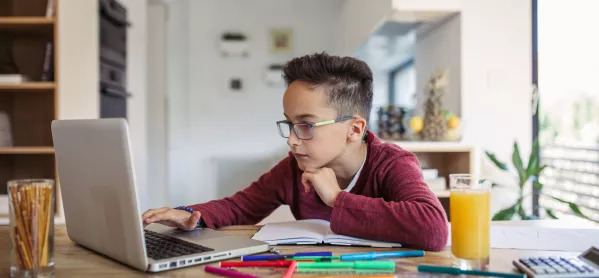
- Home
- 5 tips to help reduce student screen time
5 tips to help reduce student screen time

“How was your day today?”
It’s a question asked by parents the world over.
“It was great. I got covered in mud during PE and we had a brilliant DT lesson where we were designing and making desk lamps. I played football at lunchtime, and we won our rugby match after school.”
Of course, this rose-tinted view of an after-school chat is slightly tongue-in-cheek. The reality would probably be lacking in eloquence and enthusiasm, but the sentiment remains true - our children generally enjoy a broad, balanced curriculum, with opportunities for play and extra-curricular activities.
The understanding that we are facing an extended period of home learning is dawning on the world due to the rapid spread of Covid-19. Schools are closing their doors at an ever-increasing rate and the issue is staring the UK directly in its face.
Educators are working hard together to understand the many implications, but one thing is almost certain - technology will likely form a significant part of the solution.
The impact of technology on our wellbeing
The Pew Research Center published a recent report that discussed the benefits and risks of technology on our wellbeing.
Coming to a consensus, experts found that connective technology has evolved at a pace that outstrips our ability to make sensible decisions around its use. They recommend we examine our behaviours and ensure that we better look out for each other online.
As a group of educators facing this brave new world for the first time, we need to bear this in mind. We should acknowledge and embrace the important role that technology plays in the social side of our home learning, but we must also understand the challenges. We need to be conscious not to overuse this, ensuring that technology has a positive impact on our student’s wellbeing.
With that in mind, here are my top tips to help teachers reduce screen time for their students during home learning.
1. Timing
An hours’ worth of work in a classroom is not the same as an hours’ worth of work at home. It is a very different way of working, which just takes longer for our students.
Be conscious of this and reduce the amount of work that you would typically expect to have completed during a lesson. This prevents students from having to access online materials after the normal school day has finished just to keep up.
2. Keep it simple
This is not the time to be introducing multiple new systems for our students - where possible, stick to the websites and systems that you already use and learn to use them better.
Getting to grips with the software will result in extra time online when you’re already asking a lot of students.
Three-part lessons are really not necessary. Keep your tasks simple and concise in order to help our students focus best.
3. Attention span
Students and teachers are the same. We typically have an attention span of just six minutes before we drift and begin multi-tasking on computers. Aim to keep any video content that you produce below this length.
Try to understand this when you design your lessons, this will reduce the chance of students being distracted by other websites and social media.
4. Get creative
Understand that your aim is now to deliver the curriculum objectives - not the scheme of work. These are very different things.
The scheme of work was written for a different context: with you teaching face-to-face with your students in your classroom. Go back to what you really want your students to learn and get creative.
Use this as an opportunity to be released from the norm with a license to create. Try to use your technology for social contact and delivery of tasks but not necessarily for the completion of the tasks themselves.
5. Plan in sequences
Students may need to be put in control of planning their schedules. They are going to need to spend time with their families in different ways. They will require more flexibility.
The more that you are able to plan your lessons in sequences of three to four, the more students can take ownership of their learning and be less reliant on returning to their screens.
To infinity and beyond…
This situation is exceptionally challenging, but it is important that we realise that every cloud has a silver lining. While this particular cloud may seem particularly dark - the silver is still there to be found.
This extended period of home learning is likely to have a profound effect on the way we teach forever. I would encourage us to embrace it - but to start slowly, remembering that it is a marathon, not a sprint.
Matt Seddon is deputy head of senior school (house and pastoral) at Kellett School, a British international school in Hong Kong
Register with Tes and you can read five free articles every month, plus you'll have access to our range of award-winning newsletters.
Keep reading for just £4.90 per month
You've reached your limit of free articles this month. Subscribe for £4.90 per month for three months and get:
- Unlimited access to all Tes magazine content
- Exclusive subscriber-only stories
- Award-winning email newsletters
You've reached your limit of free articles this month. Subscribe for £4.90 per month for three months and get:
- Unlimited access to all Tes magazine content
- Exclusive subscriber-only stories
- Award-winning email newsletters



